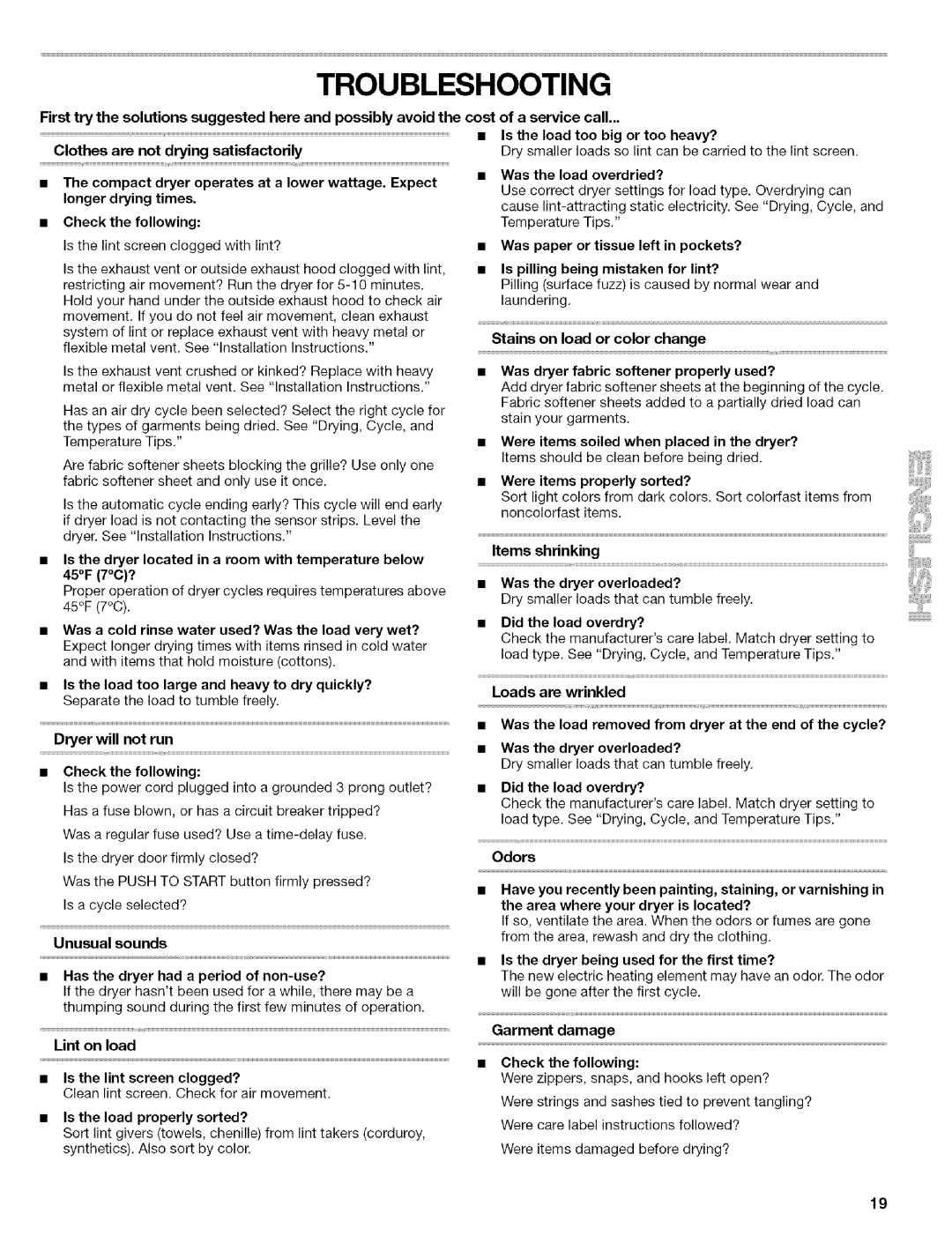
TROUBLESHOOTING
First try the solutions suggested here and possibly avoid the cost of a service call...
Clothes are not drying satisfactorily
• | The compact | dryer operates at a lower wattage. Expect |
| longer drying | times. |
• | Checkthe following: | |
| Is the lint screen clogged with lint? | |
| Is the exhaust vent or outside exhaust hood clogged with lint, | |
| restricting air movement? Run the dryer for | |
| Hold your hand under the outside exhaust hood to check air | |
| movement. If you do not feel air movement, clean exhaust | |
| system of lint or replace exhaust vent with heavy metal or | |
•
Is the load too big or too heavy?
Dry smaller loads so lint can be carried to the lint screen.
Was the load overdried?
Use correct dryer settings for load type. Overdrying can cause
Was paper or tissue left in pockets?
Is pilling being mistaken for lint?
Pilling (surface fuzz) is caused by normal wear and laundering.
flexible metal vent. See "Installation Instructions." | |
Is the exhaust vent crushed or kinked? Replace with heavy | |
metal or flexible metal vent. See "Installation Instructions." | |
Has an air dry cycle been selected? Select the right cycle for | |
the types of garments being dried. See "Drying, Cycle, and | |
Temperature Tips." |
|
Are fabric softener sheets blocking the grille? Use only one | |
fabric softener sheet and only use it once. | |
Is the automatic cycle ending early? This cycle will end early | |
if dryer load is not contacting the sensor strips. Level the | |
dryer. See "Installation | Instructions." |
Is the dryer located in a room with temperature below | |
45°F (7°C)? |
|
Proper operation of dryer cycles requires temperatures above | |
45°F (7°C). |
|
• Was a cold rinse water used? Was the load very wet? | |
Expect longer drying times with items rinsed in cold water | |
and with items that hold moisture (cottons). | |
• Is the load too large | and heavy to dry quickly? |
Separate the load to tumble freely. | |
Dryer will not run
• Checkthe following:
Is the power cord plugged into a grounded 3 prong outlet?
Has a fuse blown, or has a circuit breaker tripped?
Was a regular fuse used? Use a
Stains on load or color change
Was dryer fabric softener properly used?
Add dryer fabric softener sheets at the beginning of the cycle. Fabric softener sheets added to a partially dried load can stain your garments.
•Were items soiled when placed in the dryer? Items should be clean before being dried.
•Were items properly sorted?
Sort light colors from dark colors. Sort colorfast items from noncolorfast items.
Items shrinking
•Was the dryer overloaded?
Dry smaller loads that can tumble freely.
•Did the load overdry?
Check the manufacturer's care label. Match dryer setting to load type. See "Drying, Cycle, and Temperature Tips."
Loads are wrinkled
•Was the load removed from dryer at the end of the cycle?
•Was the dryer overloaded?
Dry smaller loads that can tumble freely.
•Did the load overdry?
Check the manufacturer's care label. Match dryer setting to load type. See "Drying, Cycle, and Temperature Tips."
Is the dryer door firmly closed?
Was the PUSH TO START button firmly pressed?
Is a cycle selected?
Unusual sounds
•Has the dryer had a period of non-use?
If the dryer hasn't been used for a while, there may be a thumping sound during the first few minutes of operation.
Odors
Have you recently been painting, staining, or varnishing in the area where your dryer is located?
If so, ventilate the area. When the odors or fumes are gone from the area, rewash and dry the clothing.
•Is the dryer being used for the first time?
The new electric heating element may have an odor. The odor will be gone after the first cycle.
Lint on load
•Is the lint screen clogged?
Clean lint screen. Check for air movement.
•Is the load properly sorted?
Sort lint givers (towels, chenille) from lint takers (corduroy, synthetics). Also sort by color.
Garment damage
Check the following:
Were zippers, snaps, and hooks left open?
Were strings and sashes tied to prevent tangling?
Were care label instructions followed?
Were items damaged before drying?
19
